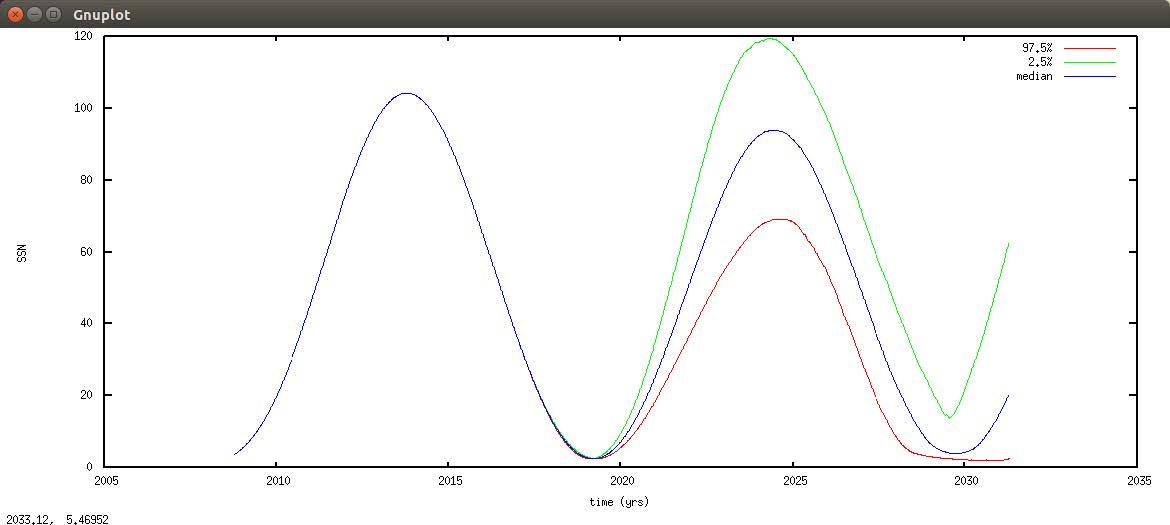I9: SolarGeoMag
> Read the articles connected to the project.
Improving Solar and Geo-dynamo predictability: towards advanced integrated data assimilation techniques
-
The main goal of the project is to improve our physical understanding, and our capability to predict, the long-term magnetic activity of the Sun and the Earth. This understanding is based on the analysis of 3D simulations that are parameterized and implemented in low dimensional models amenable to data assimilation experiments.
Three-dimensional, self-consistent numerical simulations of solar and Earth interior magnetic field generation have made tremendous progress over the past 15 years, due to the dramatic increase in computational power.
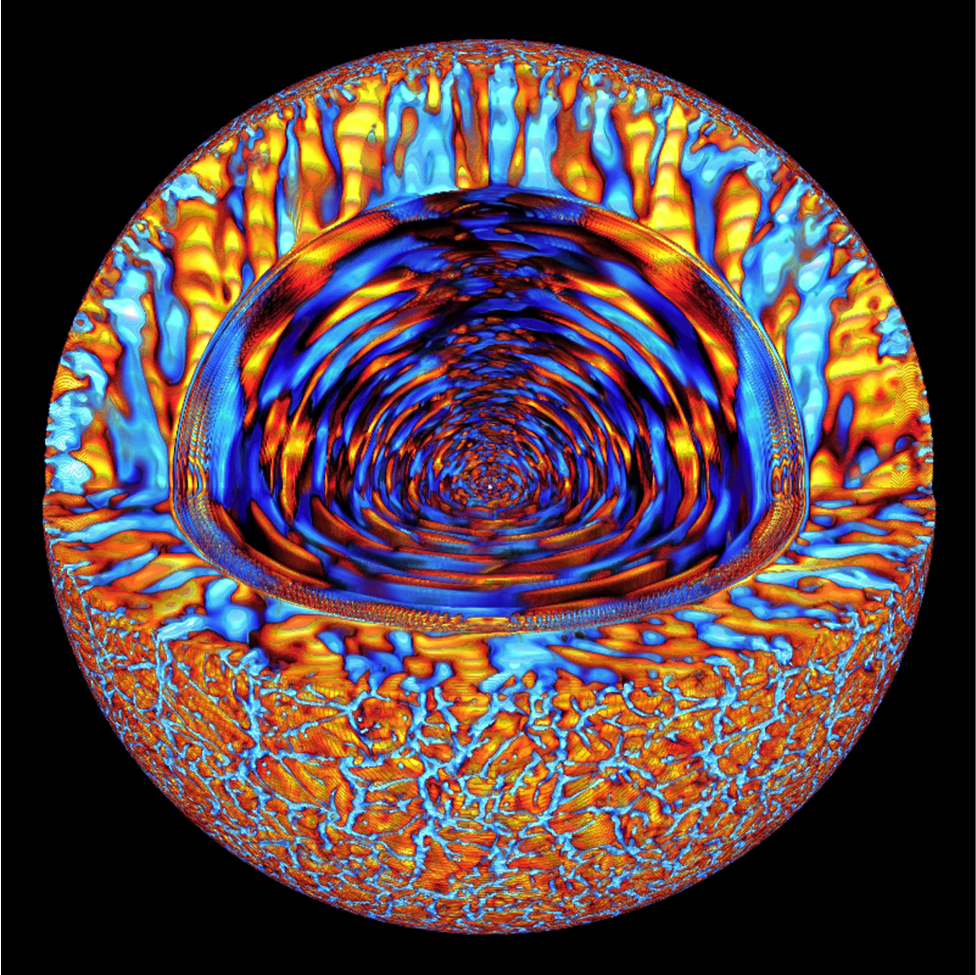
Full 3-D simulation of the Sun. Shown is the radial normalized velocity from the Sun’s core r=0 up to its surface at 99% Rsol (Alvan et al. 2015, Brun et al. 2016 in prep). Note the busy surface convective patterns and the excitation of internal gravito-inertial waves by the turbulent convective flows.
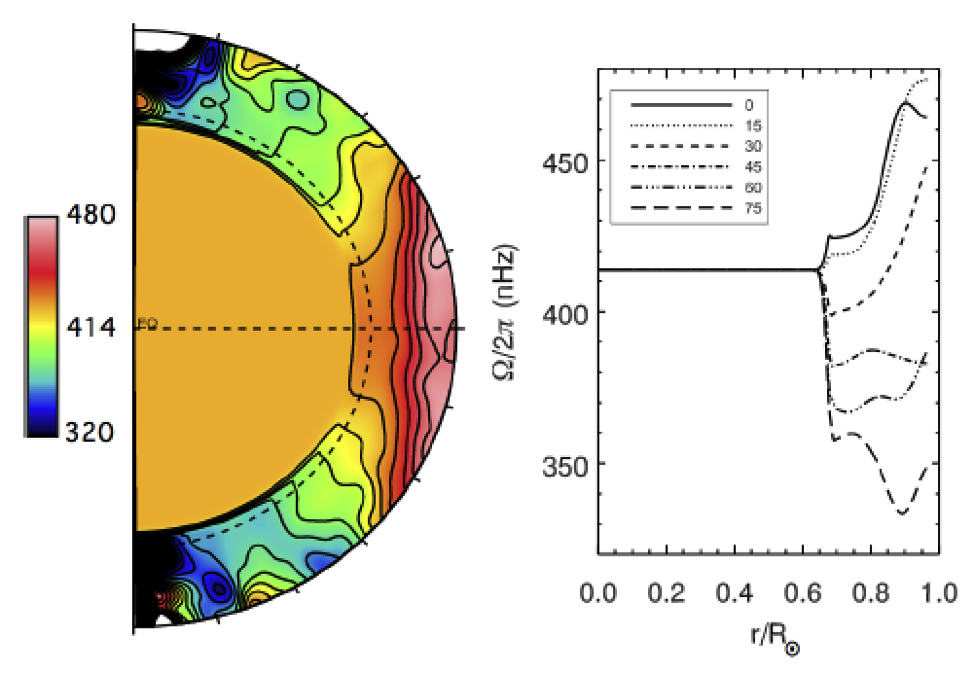
Solar rotation profile in the meridional plane as computed with ASH code in Alvan et al. 2015. Note the strong outer differential rotation and the fast transition (so-called tachocline) to inner core solid-body rotation (Alvan et al. 2015).
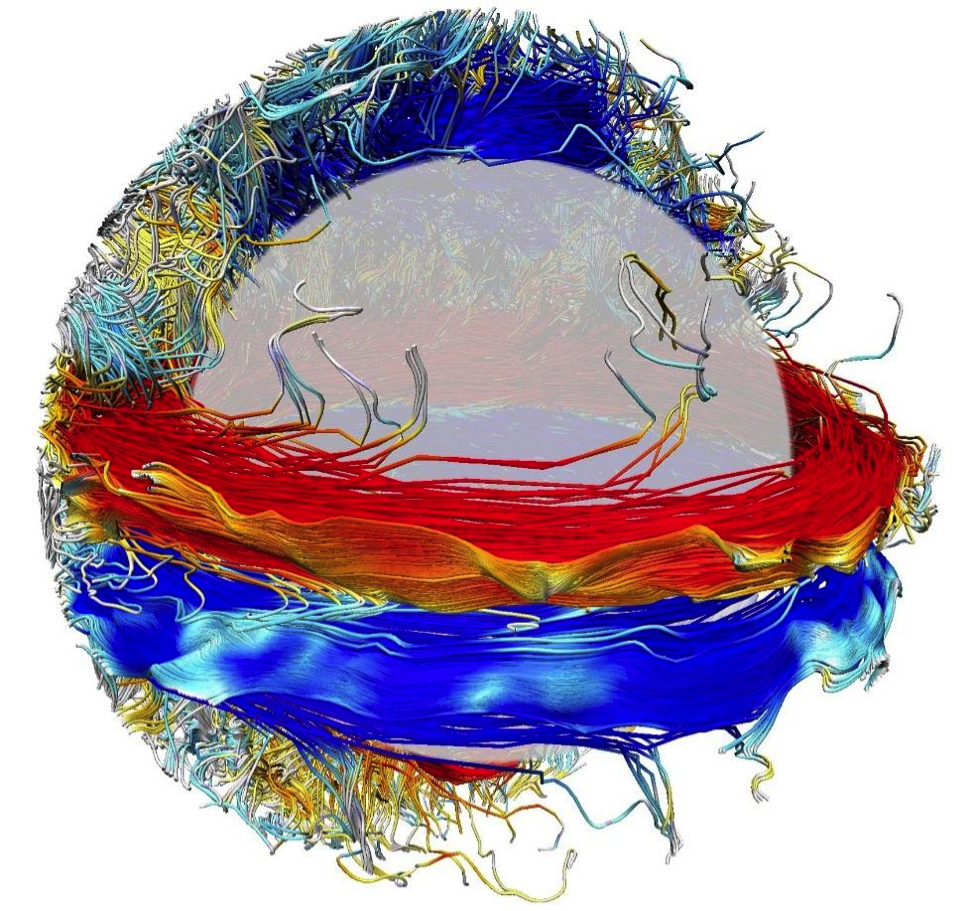
Magnetic field lines within a three-dimensional simulation of the solar dynamo computed with ASH code (after Augustson et al., ApJ, 2015)
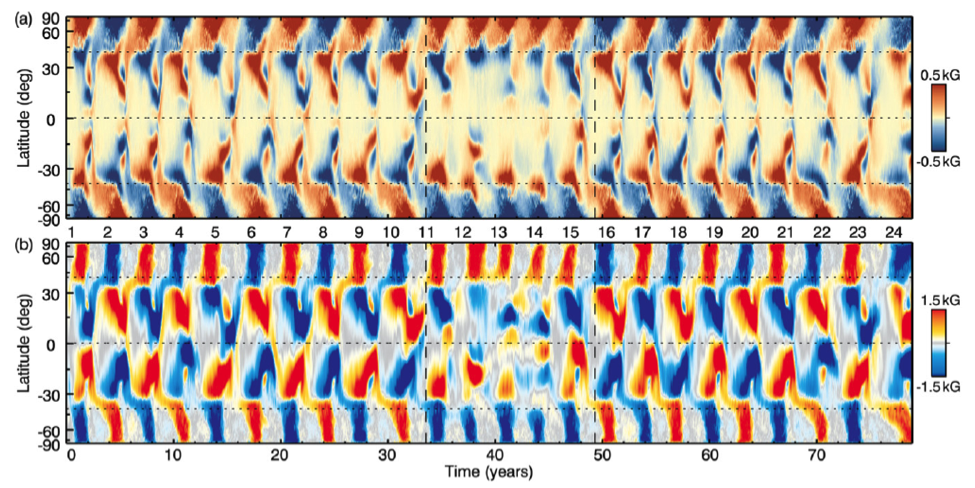
Butterfly diagram from a cyclic numerical simulation of the solar dynamo (Augustson et al., 2015). Note the equatorward propagation of the dynamo wave at mid/low latitude and the period of minima between cycle 11 and 16.
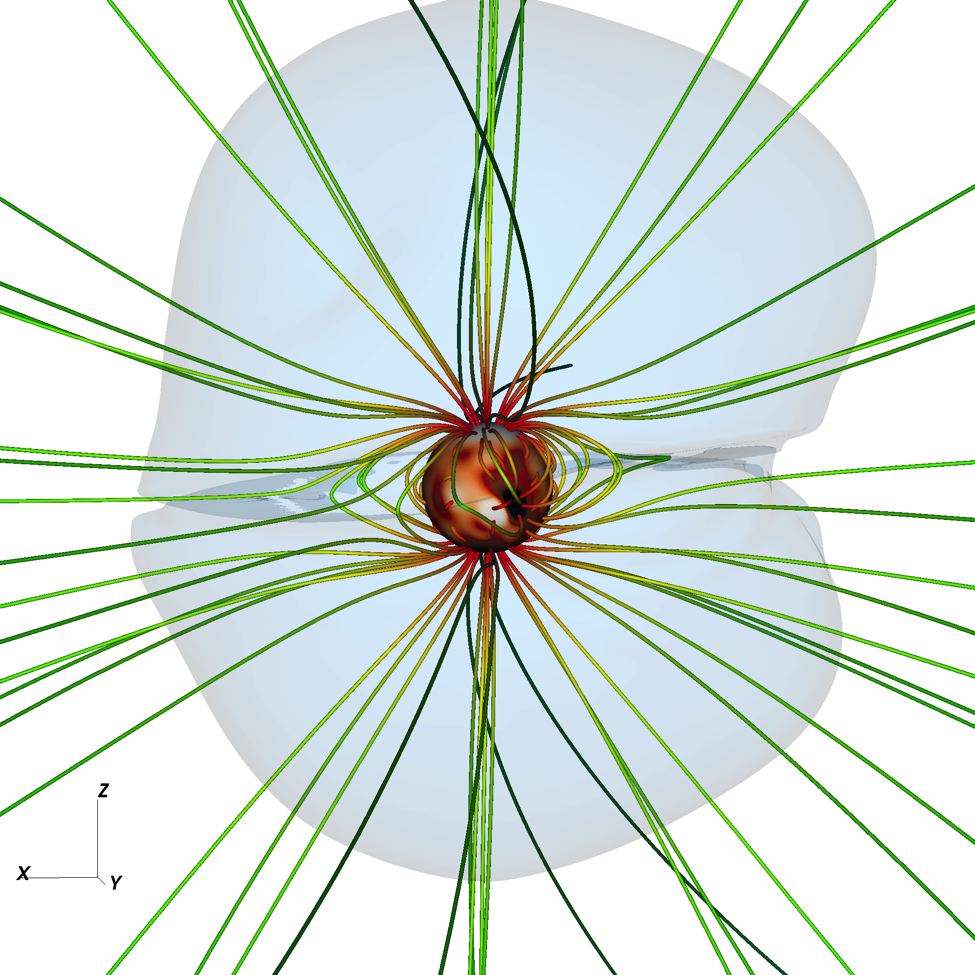
Solar Wind computed from a Wilcox Observatory magnetogram during cycle 22 using PLUTO code (Reville, Brun et al. 2015). Field lines are coded with Br amplitude and the grey shade corresponds to the Alfven surface, beyond which the wind speed is super-Alfvenic.
In parallel advanced data assimilation pipelines have been implemented in geo and solar magnetohydrodynamics (MHD) to better constrain the short-term evolution of the magnetic field B. However, predictions of the long-term magnetic variations on the Earth and the Sun are intractable with 3-D simulations. This imposes to develop more conceptual, lower dimensional models in order to support (by objective comparison with data) our 3-D studies of the origin of the long-terms variations of B, such as rare and irregular polarity reversals, or solar grand minima. Our group has developed such models (of the mean-field flux transport type) together with a variational assimilation scheme to predict solar activity over one solar cycle (11 yr). We propose here to improve these models, and to propose new models, to be able to characterize the long term behavior of the Earth and the Sun.
The questions that we address are :
- What are the physical mechanisms responsible for the long-term magnetic variability of the Sun and the Earth?
- What is the predictability of the low-frequency/rare events such as solar minima and geomagnetic reversals?
- Can we make robust forecasts of these events using, eg., partly simplified (parameterized) models?
These questions, whose answers must rely on the available observational evidence, can be cast in the general framework of data assimilation. Utilizing data assimilation techniques to study the long-term behaviour of the magnetism of the Sun and the Earth is currently out of reach if one wishes to resort to high-resolution 3-D models based on first-principles (the cost of assimilation is 10 to 100 times that of a single model integration).
Our goal is to analyze complex, 3-D simulations of the solar- and geo-dynamo in order to extract the fundamental mechanisms which control the long-term magnetic variability of these objects, and to test these mechanisms against observations by placing them at the core of conceptual models of moderate size well-suited for data assimilation. These observations include systematic sunspot count since the early 1600s for the Sun (encompassing the Maunder minimum) and geomagnetic intensity for the past 2 Myr (covering 5 reversals of polarity).
-
POSITION NAME SURNAME LABORATORY NAME GRADE, EMPLOYER WP leader Alexandre Fournier IPGP Professor (IPGP) WP co-leader A. Sacha Brun AIM Senior researcher (CEA) WP member Ching Pui Hung IPGP / AIM Post-doctoral researcher WP member Laurène Jouve IRAP / AIM Maître de conférences (U Toulouse) WP member Gauthier Hulot IPGP Senior Researcher (CNRS) WP member Thomas Gastine IPGP Junior Researcher (CNRS) -
This interface project started in 2016 and in this section we report achievements of the first two years, in relationship with the work packages we identified when we submitted SolarGeoMag.
WP1 3D simulations of the solar and Geodynamo
The goal of this task is to identify the key physical processes controlling the long-term behavior of the geo- and solar magnetic fields, through the detailed analysis of three-dimensional simulations of these systems. For the geodynamo simulations, we conducted during year 1 a series of preliminary runs to explore the sensitivity of the geomagnetic
pole location to the vigor of convection, as an indicator of the possibility for a given simulation to lead to a geomagnetic reversal (see annual report 2016 for details). At the beginning of year 2, we increased the vigor even more, and obtained a multipolar solution, ie one that does not bear any resemblance with the geodynamo (characterized by a
dipole-dominated field, which occasionally reverses). The solution remained multipolar, never returning to a dipoledominated state.
During the remainder of year 2 and year 3, we decided to continue searching for reversals in three-dimensional, convection-driven simulations of the geodynamo in a systematic way, varying the strength of the driving, the rotation rate, the mechanical boundary conditions while trying to keep the values of diffusivities as small as possible
given the available computing power (we ran simulations on national supercomputers and the S-CAPAD platform).
This is uncharted territory – previous reversal studies, for instance those of Christensen and Aubert (GJI 2006, CA2006 henceforth) were considering larger values of the diffusivities. The summary of this systematic search is displayed in Fig. 1 below. The transition between dipole-dominated and multipolar solutions had been characterized by
CA2006 by a value of the local Rossby number (a measure of the relative importance of inertial forces to Coriolis forces, based on a local scale derived from the kinetic energy spectrum) of the order of 0.1. This statement seems not to still hold for our simulations, as the transition does not appear to be sharp at all. Further decreasing the value
of the viscosity makes the transition even broader, to the point that it questions the relevance of the local Rossby number to characterize it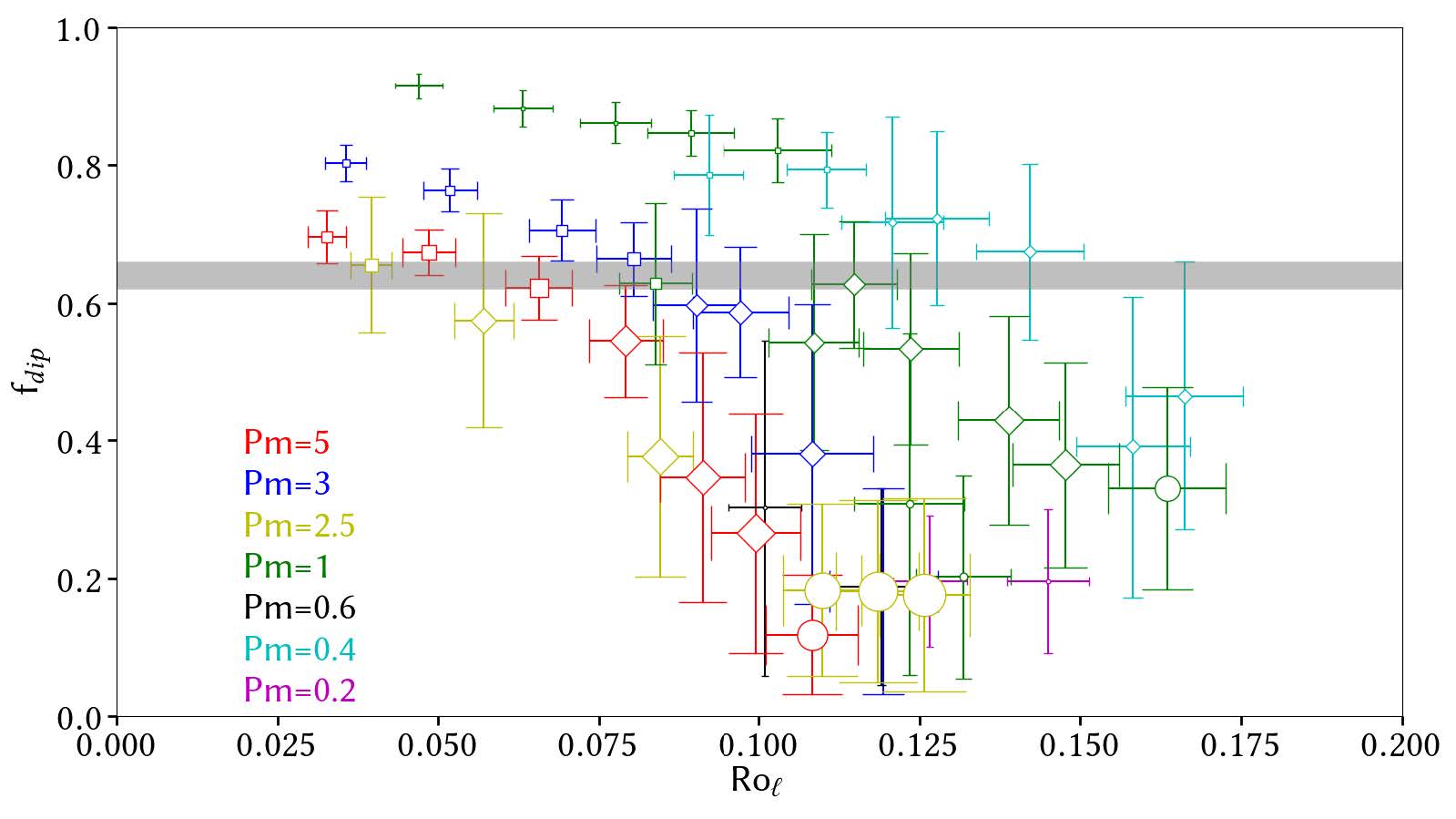 Figure 1: Measure of dipolarity vs the local Rossby number for the ensemble of 44 simulations conducted in the framework of the SolarGeoMag project. Squares denote dipole-dominated dynamos, disks denote multipolar dynamos, and diamonds dynamos
Figure 1: Measure of dipolarity vs the local Rossby number for the ensemble of 44 simulations conducted in the framework of the SolarGeoMag project. Squares denote dipole-dominated dynamos, disks denote multipolar dynamos, and diamonds dynamos
exhibiting Earth-like reversals and excursions. Color corresponds to different values of the magnetic Prandtl number. The grey line denotes the current value of the dipolarity of the Earth’s magnetic field.A first-order result based on the simulations performed is that the local Rossby number interpretation of the transition between dipole-dominated and multipolar solutions does not hold en route to Earth in parameter space. Based on this exploratory phase, we were awarded (with Nathanaël Schaeffer, from ISTerre, Grenoble), a grand challenge
allocation on the new Irene supercomputer in Saclay (23 million core hours). This also resulted in a submission of an ANR project (“RevEarth”, PI: Schaeffer, co-I: Gastine).WP2 Design of an operational tool for the prediction of solar activity
UnivEarthS Labex funded Post-doc Ching-Pui Hung kept on making considerable development for this WP, which is the one that is likely to have the broader impact. We have at our disposal an assimilation tool whose backbone is a mean-field model of the solar dynamo and which can convincingly estimate the time-dependent deep circulation within the Sun, based on the observation of sunspots and surface magnetograms. Proof-of-concept experiments
were carried out for the most part in 2016 and reported in the 2016 scientific report; their detailed analysis and their comparison with the state of the art appeared last year in the Astrophysical Journal (Hung et al., 2017).CP Hung developed a pipeline for the assimilation of real solar magnetograms. That amounted first to putting together a processing scheme that would make real data amenable to comparisons with our dynamo-based predictions. As a matter of fact, real observations contain much more details and information that can be accounted for by a mean-field model of the solar dynamo. So our first task was to get rid of the unwanted details in the real magnetograms (essentially their high-frequency content in space and time). We next carried out a first round of assimilation experiments (some of which were reported in the International Astronomical Union meeting in July 2017 in Exeter by C. P Hung and A. S. Brun).
Figure 2: An example of a preliminary forecast of solar activity, based on our variational assimilation framework, for solar cycle 25. Plotted is a proxy for the Sunspot number vs time. The blue curve is the mean prediction. The solar maximum is expected for
the Spring 2024.Since then, our efforts were focused on putting together a sensible prediction of solar activity for cycle 25. Our strategy has been the following: begin by defining a steady large-scale circulation that can account for the data (magnetograms and timeseries of sunspot number) available for cycle 24. This defines a base state. Perturb this base state
at t=today by stochastic fluctuations of the velocity, and use the ensemble of forecasts so generated to produce a forecast for cycle 25, whose uncertainty is described by the spread of the ensemble. The magnitude of velocity fluctuations is chosen in order to explain (statistically) the variability of solar activity (as measured by the sunspot number)
over the last 6 solar cycles. A preliminary forecast is shown in Figure 2.WP3 Long-term predictability of geomagnetic reversals (and long-term variability of the solar dynamo)
With regard to geomagnetic reversals, the start of this WP was contingent on the completion of WP1, which took longer than expected. This work will be undertaken under a different umbrella than that of the LabEx, most likely the ANR, if the RevEarth project (see above) happens to be funded.
-
C. P. Hung, A. S. Brun, A. Fournier, L. Jouve, O. Talagrand, and M. Zakari, Variational estimation of the large scale time dependent meridional circulation in the Sun: proofs of concept with a solar mean field solar dynamo model, accepted for publication in the Astrophysical Journal. 2017.
http://arxiv.org/abs/1710.02114C. P. Hung, A. S. Brun, A. Fournier, L. Jouve, O. Talagrand, and M. Zakari , Estimating the Solar Meridional Flow and Predicting the 11-yr Cycle Using Advanced Variational Data Assimilation Techniques, Space Weather of the Heliosphere: Processes and Forecasts, Proceedings IAU Symposium No. 335, 2017, Claire Foullon & Olga Malandraki, ed.
Coarse predictions of dipole reversals by low-dimensional modeling and data assimilation, by M. Morzfeld, A.Fournier, and G. Hulot, 262, 8-27, 2017. doi: 10.1016/j.pepi.2016.10.007 (in connection with WP2)
Sandpile models and solar flares: eigenfunction decomposition for data assimilation, by A. Strugarek, A. S. Brun, P.Charbonneau and N. Vilmer, Space Weather of the Heliosphere: Processes and Forecasts, Proceedings IAU Symposium No. 335, 2017, Claire Foullon & Olga Malandraki, ed. Submitted
Hung, C.P., Jouve, L., Brun, A.S., Fournier, A., and Talagrand O., Estimating the deep solar meridional circulation using magnetic observations and a dynamo model: a variational approach,The Astrophysical Journal, 814, 151 (21 pp), 2015. doi:10.1088/0004-637X/814/2/151
Svanda, M., Brun, A.S., Roudier, T., Jouve, L., Polar cap magnetic field reversals during solar grand minima: could pores play a role?, Astronomy and Astrophysics, 586, A123 (11 pp), 2016.
10.1051/0004-6361/201527314Brun, A.S., Browning, M.K., Dikpati, M., Hotta, H., Strugarek, A., Recent Advances on Solar Global Magnetism and Variability, Space Science Reviews, 196, 101 (35 pp), 2015
Réville, V., Brun, A.S., Strugarek, A., et al., From Solar to Stellar Corona: The Role of Wind, Rotation, and Magnetism, The Astrophysical Journal, 814, 99 (9 pp), 2015
10.1088/0004-637X/814/2/99Alvan, L., Strugarek, A., Brun, A.S., Mathis, S., Garcia, R.A., Characterizing the propagation of gravity waves in 3D nonlinear simulations of solar-like stars, Astronomy and Astrophysics, 581, A112 (13 pp), 2015.
Augustson, K., Brun, A.S., Miesch, M., Toomre, J., Grand Minima and Equatorward Propagation in a Cycling Stellar Convective Dynamo, The Astrophysical Journal, 809, 149 (25 pp), 2015

